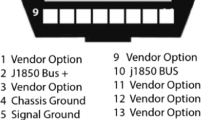Abstract
The primary objectives of this work were to devise an effective subjective evaluation method for automobile power performance based on regression analysis combined with the analytic hierarchy process (RA-AHP) and to propose a reliable, convenient approach for establishing an evaluation system for automobile power performance. To validate this method, four vehicles were selected, and 30 drivers completed a test drive on a selected route. A five-level Likert questionnaire was designed to subjectively evaluate automobile power performance. The test data were then compiled and used to establish an evaluation system based on the RA-AHP method, and the results from the evaluation system were compared with the vehicle sequence results from the drivers. The comparison showed that the results were the same and thus verified the feasibility of the RA-AHP method. This method is suitable for automobile companies to establish a subjective evaluation system of automobile power performance and can also be used in other fields to build a comprehensive evaluation system.









Similar content being viewed by others
References
Andersson D, Rankin A, Diptee D (2017) Approaches to team performance assessment: a comparison of self-assessment reports and behavioral observer scales. Cogn Technol Work. https://doi.org/10.1007/s10111-017-0428-0
Ashtiani M, Azgomi MA (2015) A multi-criteria decision-making formulation of trust using fuzzy analytic hierarchy process. Cognit Technol Work. https://doi.org/10.1007/s10111-014-0310-2
Ayd S, Kahraman C (2014) Vehicle selection for public transportation using an integrated multi criteria decision making approach: a case of Ankara. J Intell Fuzzy Syst. https://doi.org/10.3233/IFS-130917
Badrkhani M, Ahmadi H (2014) Identifying and sorting key factors which affect customers satisfaction in vehicle industry by using AHP pair matrix. Asian J Res Mark 3(6):142–156
Chen T (2009) Methods and index weight analysis for subjective assessment on automobile dynamic properties. Dissertation, Hunan University. (in Chinese)
Chen M, Guo LX (2013) Comprehensive evaluation of power performance and energy consumption economy of battery electric vehicle based on AHP-entropy-TOPSIS. J Mach Design 30(4):15–19. (in Chinese)
Damle AM, Keswani IP (2015) Selection of fuel by using analytical hierarchy process. Int J Eng Res Appl 5(4):91–94
Docin (2018) The subjective evaluation indices for vehicle power performance. http://www.docin.com/p-1158007893.html. Accessed 26 Mar 2018 (in Chinese)
Dorey R, Holmes C (1999) Vehicle driveability—its characterisation and measurement. SAE Technical paper. https://doi.org/10.4271/1999-01-0949
Gim B, Kim JW (2014) Multi-criteria evaluation of hydrogen storage systems for automobiles in Korea using the fuzzy analytic hierarchy process. Int J Hydrog Energy. https://doi.org/10.1016/S0965-8564(03)00027-2
Gómez GLG, Nybacka M, Bakker E et al (2016) Objective metrics for vehicle handling and steering and their correlations with subjective assessments. Int J Automot Technol. https://doi.org/10.1007/s12239-016-0077-y
Guo R, Zhang Y (2014) Exploration of correlation between environmental factors and mobility at signalized intersections. Transp Res Part D. https://doi.org/10.1016/j.trd.2014.05.011
Harris D, Chan-Pensley J, Mcgarry S (2005) The development of a multidimensional scale to evaluate motor vehicle dynamic qualities. Ergonomics. https://doi.org/10.1080/00140130500181967
Heißing B, Brandl HJ (2002) Subjektive Beurteilung des Fahrverhaltens. Vogel, pp 164
Khalilikhah M, Heaslip K, Hancock K (2016) Traffic sign vandalism and demographics of local population: a case study in Utah. J Traffic Transp Eng. https://doi.org/10.1016/j.jtte.2015.11.001
Li B (2008) Research on subjective evaluation of powertrain performance and brake performance of automobile. Dissertation, Jilin University (in Chinese)
Li SH (2012) Research on evaluation system of new energy vehicles based on AHP. Appl Mech Mater. https://doi.org/10.4028/www.scientific.net/AMM.260-261.321
Li B, Zhang MZ (2000) The analysis of vehicle system based on AHP. J Jiangsu Univ Sci Technol (Natural Sci) 21(4):24–27. (in Chinese)
Ling NX (2014) Regression analysis. In: Ling NX, Li WS, Ning RJ (eds) Mathematics statistics. University of Science and Technology of China, Anhui, pp 168–214, (in Chinese)
Luo HW, Ruan JJ, Li F (2014) A fuzzy evaluation and AHP based method for the energy efficiency evaluation of EV charging station. J Comput. https://doi.org/10.4304/jcp.9.5.1185-1192
Tian XX (2014) Research on subjective evaluation method of automobile performance. Dissertation, Chang’an University. (in Chinese)
Tian J, Dai Y (2014) Research on the relationship between mishap risk and time margin for control: a case study for carrier landing of aircraft. Cogn Technol Work. https://doi.org/10.1007/s10111-013-0262-y
Turcksin L, Bernardini A, Macharis CA (2011) combined AHP-PROMETHEE approach for selecting the most appropriate policy scenario to stimulate a clean vehicle fleet. Procedia Soc Behav Sci. https://doi.org/10.1016/j.sbspro.2011.08.104
Yedla S, Shrestha RM (2003) Multi-criteria approach for the selection of alternative options for environmentally sustainable transport system in Delhi. Transp Res Part A. https://doi.org/10.1016/S0965-8564(03)00027-2
Yu Q, Hou F (2016) An approach for green supplier selection in the automobile manufacturing industry. Kybernetes. https://doi.org/10.1108/K-01-2015-0034
Yu ZS (2009) Automobile power performance. In: Yu ZS, Xia QS et al (eds) Automobile theory. China Machine Press, Beijing, pp 1–40. (in Chinese)
Zhang ZQ, Xu B, He YL (2008) Engine performance evaluation based on analytic hierarchy process. Acta Armamentarii 29(5):625–628. (in Chinese)
Acknowledgements
This paper is supported by the “National Natural Science Foundation of China” (Nos. 51578207, 51678211), the “Fundamental Research Funds for the Central Universities” (No. JZ2017HGTB0209), and “Anhui Science and Technology Project - Sci-tech Police” (No. 1704d0802189).
Author information
Authors and Affiliations
Corresponding author
Rights and permissions
About this article
Cite this article
Jiang, K., Luo, Z., Feng, Z. et al. Subjective evaluation of automobile power performance based on RA-AHP. Cogn Tech Work 20, 413–424 (2018). https://doi.org/10.1007/s10111-018-0488-9
Received:
Accepted:
Published:
Issue Date:
DOI: https://doi.org/10.1007/s10111-018-0488-9




